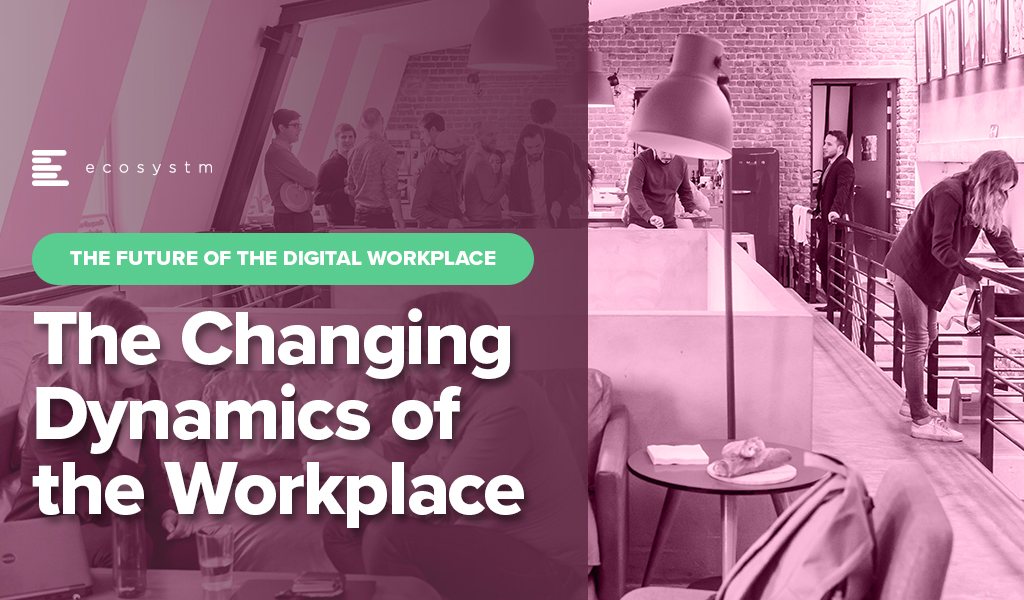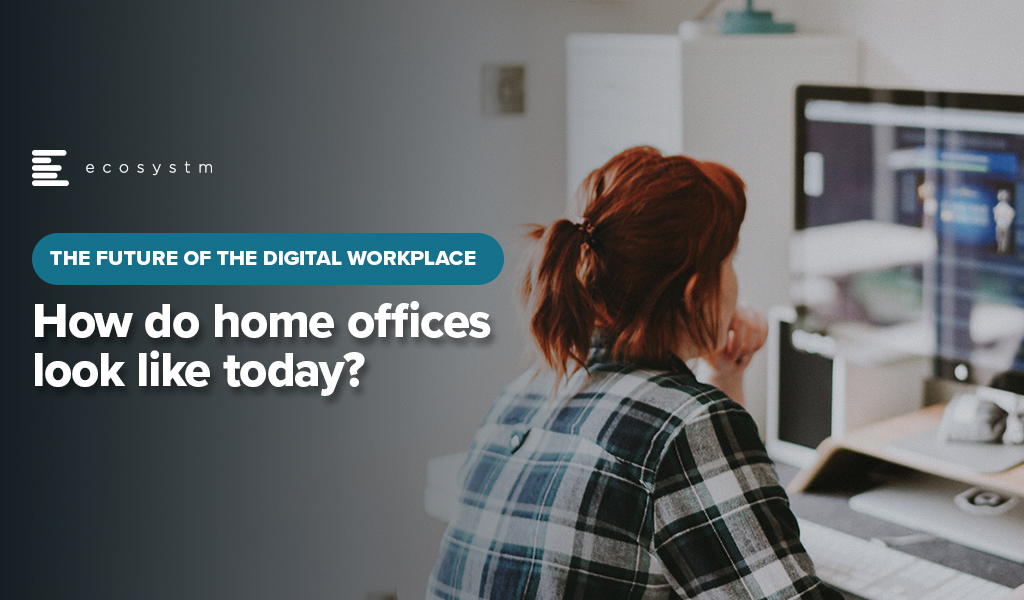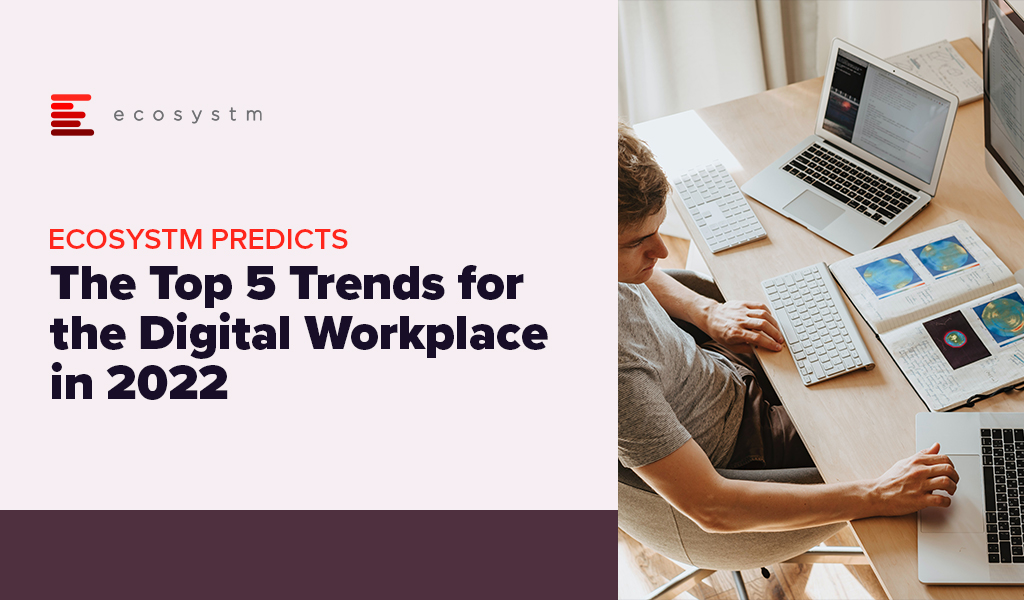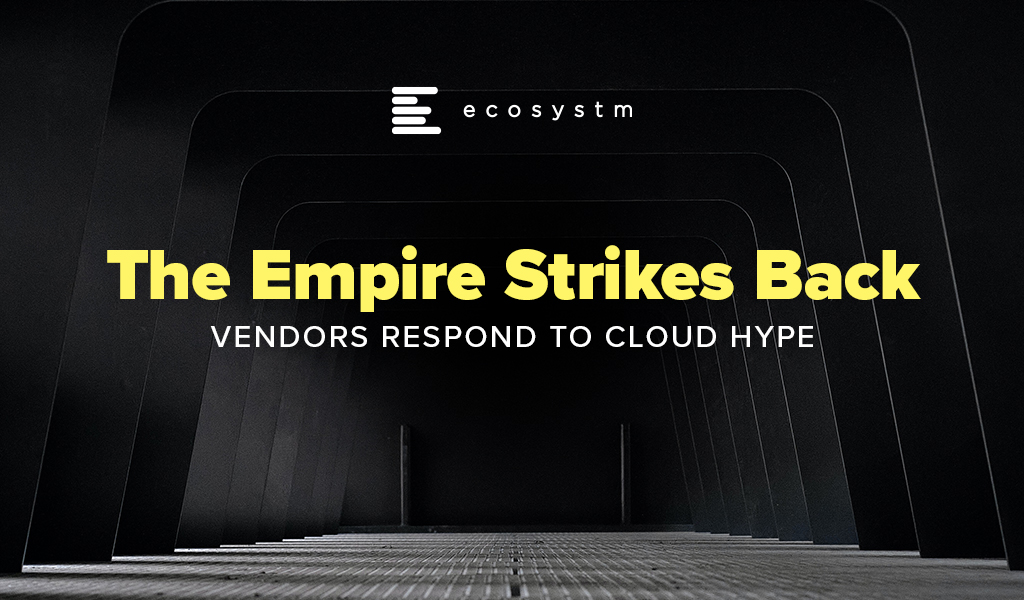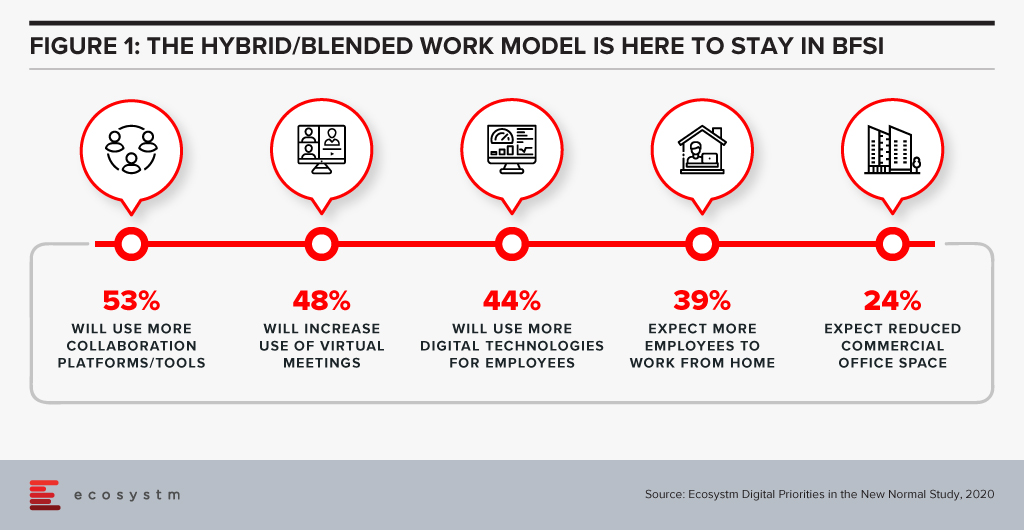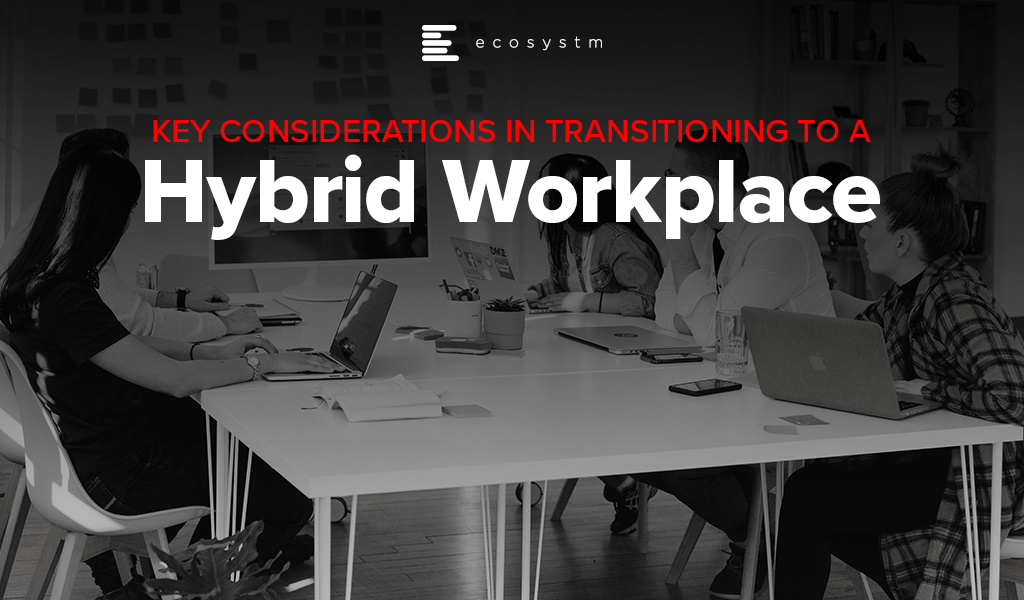For the last two years organisations have been forced to invest on digital services for their customers and giving their employees access to the right technologies to allow them to work from home – or from anywhere they choose to. Organisations find that they have to continue to evolve – and are now looking to build a ‘Digital Workplace’ that caters to the hybrid workplace.
As organisations in ASEAN define the work model that works for their business operations, work culture and organisational goals, there are a few areas that they must focus on.
Here are 5 insights from the Ecosystm Voice of the Employee Study that will help you shape your Digital Workplace.
- Evolve the physical workplace. 72% of knowledge workers in ASEAN will work both remotely and from the office.
- Build a true hybrid work culture. As organisations form their Digital Workplace strategy, they will have to ensure that the workplace is as comfortable as home offices!
- Focus on employee wellbeing. Only 25% of organisations in ASEAN have made changes to their HR policies in the last two years.
- Invest in the right technologies. To build that resilient hybrid workplace, organisations will first have to conduct a gap analysis and consolidation of their tech investments over the last two years.
- Continue to monitor employee behaviour patterns. As organisations work towards a ‘Return to Work’ policy, they will see significant changes in employee usage behaviour patterns. If the right cyber practices are not in place, this could leave organisations vulnerable again.
Read on for more insights

The way we work in Australia and New Zealand (ANZ) is changing. In 2020 “work” went from a place you go to something you do.
Through the many restrictions in 2020 and 2021, knowledge workers in ANZ changed their work behaviours and employers changed their expectations of their employees. Tighter border controls and fast economic recoveries have swung the pendulum in the favour of employees, and “The Great Resignation” has started to play out across the region.
The Ecosystm Voice of the Employee Study aims to explore the emerging global Future of Work trends from an employee’s point-of-view. In an environment of uncertainty, this study is designed to be an ongoing, dynamic study that will be able to track the major shifts in preferences, perceptions, and practices through 2022.
Here are some insights from the study that can help businesses in ANZ develop strategies and capabilities to better serve their remote and office-based employees.
- The Great Resignation has begun in ANZ
- Women are more likely to work entirely from home
- Those working entirely from home are more likely to change jobs/careers in 2022
- Knowledge workers in ANZ are enjoying the Work from Home model
- Employees are looking for more flexibility and choice
Read on to find out more.

The Ecosystm Voice of the Employee Study reveals that 76% of your employees have a dedicated home office, which they have continually enhanced over the last two years. Now that you are working to bring these employees back to the office, are you focusing on giving them the same technology and environment that they have become used to?

Download the Ecosystm Voice of Employee Study infographic as a PDF

The first impact of the pandemic and the disruption it caused, was organisations scrambling to empower their remote employees. Over the last 2 years, significant investments have been made on collaboration platforms and tools. Now organisations are having to work towards making these workplaces truly hybrid where organisations have to ensure that all employees get the same experience, irrespective of where they choose to work from.
In 2022, organisations will continue to invest in building the Digital Workplace and address the associated technology, people, and process challenges.
Read on to find out what Ecosystm Analysts, Audrey William, Tim Sheedy and Venu Reddy think will be the key trends for the Digital Workplace in 2022.
Click here to download Ecosystm Predicts: The Top 5 Trends for the Digital Workplace in 2022 as PDF

Cisco’s annual WebexOne conference was held on 26-27 October featuring over 30 sessions with thought leaders, guest speakers, technology partners and Cisco executives. This year’s event focused on how the company and its ecosystem of partners will continue to enable the Future of Work.
In the last year, Cisco has added more than 1,000 features to its Webex platform and made 5 key acquisitions. But from the event, it became apparent that the company is continuing to work on product differentiation and making hybrid work a more productive and human experience.
Read on to find what Ecosystm analysts, Audrey William, Sash Mukherjee, Tim Sheedy, Ullrich Loeffler and Venu Reddy found interesting about the announcements at WebexOne 2021.
To download this VendorSphere as a pdf for easier sharing, please click here.
“Cloud is universal – everything is going to be on the cloud soon! If you are not moving to the cloud, you are going extinct! AWS, Microsoft and Google are going to rule the world!” This has been the hyped narrative for some time now. But watch out New World – the Old World is fighting back!
Traditional vendors like HP Enterprise, Cisco, and Oracle are all deploying strategies to remain relevant in the new world. For these vendors – especially for HPE and Cisco that come from a predominantly hardware background – the future is hybrid. They picture a world in which the data centre – either on-prem or in a co-located facility – thrives on, in tandem with the cloud. This is a reasonably good bet. For most large enterprises with a huge repository of applications and data sitting in the data centre, migrating everything to the cloud is a nightmare – fraught with risk and very expensive.
Ecosystm research shows that 32% of organisations have deployed containerisation – and this percentage will only grow. The ability for firms to toggle between data centre bare metal based applications and completely on-the-cloud ones is becoming more manageable by the day. This enormous flexibility allows a firm that has large compute needs to keep some stable workloads in a data centre, whether on-prem or co-located, while simultaneously using cloud-based workloads, optimising spends and performance.
Here is a glimpse into the strategies of three key vendors.
HPE’s ‘as-a-service’ Messaging is Spot on
Two years ago, Antonio Neri boldly went where no HPE CEO had gone before, promising that HPE’s entire portfolio would be available ‘as-a-service’ within 3 years. At the recently concluded HPE Discover event, there were a flurry of announcements to showcase that GreenLake is indeed on its way to meet that ambitious goal in 2022.
HPE’s recent announcements show customers that GreenLake is an end-to-end solution for managing their IT infrastructure moving forward. It ticks all the boxes: providing flexibility and scalability; the advantage of using both data centre and cloud; and high manageability and security with a full suite of applications.
Examples are the partnership with Azure Stack HCI, to add to earlier ones with leading vendors like SAP, Citrix, and VMware. HPE is building a platform that provides customers with the comfort that they can adopt GreenLake and pretty much have access to any application they may choose to implement – offering full coverage from the Edge to the Cloud. It is extremely interesting that GreenLake allows the option of switching on and switching off processor cores as needed, and the customer pays based on usage. This is surely a first for the industry!
Another example is Lighthouse, which allows the customer to rapidly configure, and provision workloads based on dynamic needs. While all the hyperscalers provide similar services when the workload is on the cloud, Lighthouse allows the same flexibility and speed for cloud services which can be run in the data centre, on-prem, co-located, or even at the Edge.
A third example was the announcement of Project Aurora which will add an additional security layer from validating the input data all the way to verifying the workload at the start and then as it is running. It appears to use an AI/ML system that checks for unexpected behaviours to detect any kind of malware.
It makes good sense for HPE to push GreenLake and move to offering ‘everything-as-a-service’. As one of the incumbent enterprise hardware business leaders, this is a good response rather than to watch one’s business continue to shrink YoY. GreenLake is HPE’s way of futureproofing themselves and making sure they stay relevant in the new cloud world.

Cisco Secures the Hybrid Workplace
Cisco has been active launching Cisco Plus earlier this year, as their bridge to the as-a-service model with a network-as-a-service (NaaS) offering. Somewhat like GreenLake, Cisco Plus offers flexible consumption for compute, storage, and networking. They are committed to offering most of their portfolio as-a-service over time.
Cisco has shown some resilience in terms of revenue but has still been struggling to grow. After a steady growth since 2017, the revenues dropped by 7% in 2020 almost as a direct impact of COVID-19. The post-pandemic world has the potential of being a bigger threat for Cisco. Many estimates show the number of people working from home is likely to go up dramatically and Cisco’s key networking offering could rapidly become redundant. However, at Ecosystm we believe that the hybrid work model will be predominant.
Cisco is also betting on a hybrid world. No matter where one works from, there are networking needs. Cisco’s focus, therefore, is on security – this will be on the mind of virtually any enterprise as it chalks out its future strategy. With a hybrid environment, making everything secure becomes more complex while continuing to be vital. Cisco has a heavy emphasis on Secure Access Service Edge (SASE) – the idea that the security envelope now has to be a flexible form that has a presence everywhere that the enterprise needs to be. This will make a lot of sense to most enterprises as they tread the hybrid path.
Cisco will offer a portfolio of tools to make it increasingly easier for customers to use multi-cloud, multi-vendor environments, offering the best of both worlds.
Oracle Incentivises Cloud Migration
Oracle has a different approach because they are trying to solve a different problem. They are competing with the hyperscalers, while fully acknowledging a hybrid world. However, as a company with less legacy in hardware, it makes sense for them to focus on migrating to cloud rather than on hybridisation. Oracle has just announced that they will subsidise existing customers who add cloud workloads with them, by providing discounts on the existing licensing fees that the customer is paying Oracle. This discount appears to be around 25% to 33%. In essence, this means that if a customer spends about USD 100k with Oracle on licensing and decides to start moving workloads to the Oracle Cloud worth somewhere between USD 300-400k, they can potentially write off the entire license fees they are currently paying!
Conclusion
There is a strong effort from every vendor right now to retain and consolidate their customer share and build a vision that convinces the customer that they are the way to go. For the traditional hardware players that vision is of a hybrid world – attractive to today’s large enterprise. For the likes of AWS, Microsoft, Google, and Oracle it is all about moving the customer to their cloud. The assumption of course is that moving someone to your cloud will lead to more of your apps being used by the customer. For the hardware vendors like Cisco and HPE, it is all about moving the customer to their own platforms which empower hybridisation. In all cases, a necessary component is to offer ‘everything-as-a-service’ upending the traditional models of selling.
In my opinion, with time the IaaS portion of the cloud is likely to gradually devolve into something like a utility. There will be a lot of upheavals and market disruption before we get there, but eventually, software and other services are likely to stand separate from the infrastructure provider. All the vendors are therefore depending on capturing the customer at the platform-as-a-service (PaaS) level, but even this is likely to get commoditised over time. Eventually, the winners will be disparate providers of the best applications for different functions. Meanwhile, we are in for an extremely interesting ride as we see all the vendors jockeying for space!

Organisations are finding that the ways to do work and conduct business are evolving rapidly. It is evident that we cannot use the perspectives from the past as a guide to the future. As a consequence both leaders and employees are discovering and adapting both their work and their expectations from it. In general, while job security concerns still command a big mindshare, the simpler productivity measures are evolving to more nuanced wellness measures. This puts demands on the CHRO and the leadership team to think about company, customer and people strategy as one holistic way of working and doing business.
Organisations will have to re-think their people and technology to evolve their Future of Work policies and strategise their Future of Talent. There are multiple dimensions that will require attention.
Hybrid is Becoming Mainstream
It is clear that hybrid workplaces are here to stay. Ecosystm research finds that in 2021 BFSI organisations will use more collaboration tools and platforms, and virtual meetings (Figure 1). Nearly 40% expect more employees to work from home, but only about a quarter of organisations are looking to reduce their physical workspaces. Organisations will give more choice to employees in the location of their work – and employees will choose to work from where they are more productive. The Hybrid model will be more mainstream than it has been in the last few months.
Companies are coming to terms with the fact that there is no single answer to operating in the new world. Experimentation and learnings are continuously captured to create the right workforce and workplace model that works best. Agility both in terms of being able to undersand the market as well as quickly adapt is becoming quite important. Thus being able to use different models and ways of working at the same time is the new norm.
Technology and Talent are Core
Talent and tech are the two core pillars that companies need to look at to be successful against their competition. It is becoming imperative to create synergy between the two to deliver a superior value proposition to customers. Companies that are able to bring the customer and employee experience journeys together will be able to create better value. HR tech stacks need to evolve to be more deliberate in the way they link the employee experience, customer experience, and the culture of the organisation. That’s how the Employee Value Proposition (EVP) comes to life on a day-to-day basis to the employers. With evolving work models, the tech stack is a key EVP pillar.
Governments will also need to partner with industry to make such talent available. Singapore is rolling out a new “Tech.Pass” to support the entry of up to 500 proven founders, leaders and experts from top tech companies into Singapore. Its an extension of the Tech@SG program launched in 2019, to provide fast-growing companies greater assurance and access to the talent they need. The EDB will administer the pass, supported by the Ministry of Manpower.
Attracting the Right Talent
Talent has always been difficult to find. Even with globalisation, significant investment of time and resources is needed to find and relocate talent to the right geography. In many instances this was not possible given the preferences of the candidates and/or the hiring managers. COVID-19 has changed this drastically. Remote working and distributed teams have become acceptable. With limitations on immigration and travel for work, there is a lot more openness to finding and hiring talent from outside the traditional talent pool.
However it is not as simple as it seems. The cost per applicant (CPA) – the cost to convert a job seeker to a job applicant – had been averaging US$11-12 throughout 2019 according to recruiting benchmark data from programmatic recruitment advertising provider, Appcast. But, the impact of COVID-19 saw the CPA reach US$19 in June – a 60% increase. I expect that finding right talent is going to be a “needle in a haystack” issue. But this is only one side of the coin – the other aspect is that the talent profile needed to be successful in roles that are all remote or hybrid is also significantly different from what it was before. Companies need to pay special attention to what kind of people they would like to hire in these new roles. Without this due consideration it is very likely that there would be difficulty in on-boarding and making these new hires successful within the organisation.
Automation Augmentation and Skills
The pace at which companies are choosing to automate or apply AI is increasing. This is changing the work patterns and job requirements for many roles within the industry. According to the BCG China AI study on the financial sector 23% of the roles will be replaced by AI by 2027. The roles that will not be replaced will need a higher degree of soft skills, critical thinking and creativity. However, automation is not the endgame. Firms that go ahead with automation without considering the implications on the business process, and the skills and roles it impacts will end up disrupting the business and customer experience. Firms will have to really design their customer journeys, their business processes along with roles and capabilities needed. Job redesign and reskilling will be key to ensuring a great customer experience
Analytics is Inadequate Without the Right Culture
Data-driven decision-making as well as modelling is known to add value to business. We have great examples of analytics and data modelling being used successfully in Attrition, Recruitment, Talent Analytics, Engagement and Employee Experience. The next evolution is already underway with advanced analytics, sentiment analysis, organisation network analysis and natural language processing (NLP) being used to draw better insights and make people strategies predictive. Being able to use effective data models to predict and and draw insights will be a key success factor for leadership teams. Data and bots do not drive engagement and alignment to purpose – leaders do. Working to promote transparency of data insights and decisions, for faster response, to champion diversity, and give everyone a voice through inclusion will lead to better co-creation, faster innovation and an overall market agility.
Creating a Synergy
We are seeing a number of resets to what we used to know, believe and think about the ways of working. It is a good time to rethink what we believe about the customer, business talent and tech. Just like customer experience is not just about good sales skills or customer service – the employee experience and role of Talent is also evolving rapidly. As companies experiment with work models, technology and work environment, there will a need to constantly recalibrate business models, job roles, job technology and skills. With this will come the challenge of melding the pieces together within the context of the entire business without falling into the trap of siloed thinking. Only by bringing together businesses processes, talent, capability evolution, culture and digital platforms together as one coherent ecosystem can firms create a winning formula to create a competitive edge.
Singapore FinTech Festival 2020: Talent Summit
For more insights, attend the Singapore FinTech Festival 2020: Infrastructure Summit which will cover topics on Founders success and failure stories, pandemic impact on founders and talent development, upskilling and reskilling for the future of work.

The past 3-4 months have seen technology leaders move mountains to support their newly remote employees and 100% digital customers. Over 40% of businesses in the Asia Pacific didn’t formally support remote working – so these companies have made massive changes in support of their employees. You have rolled out new hardware, new data protection and compliance policies, new security measures, collaboration software and VPNs. You have also strengthened the IT Helpdesk to better support remote employees and digital customer processes. And you are embracing the public cloud to offer new services and capabilities to customers and staff. The pace of change has been breathtaking – and things are not slowing down.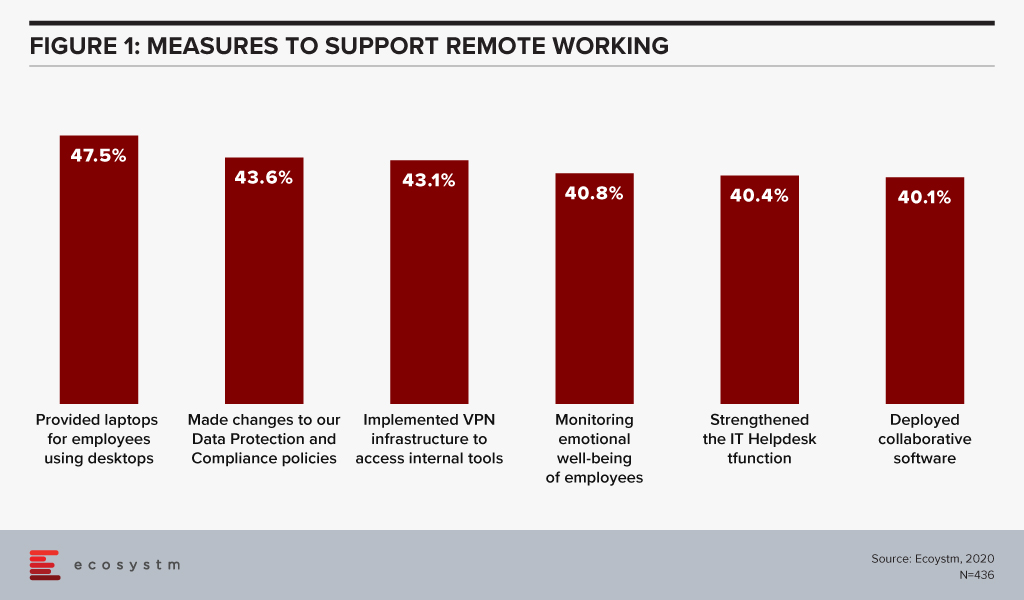
Many countries or economies are now moving to a hybrid working arrangement. This ISN’T about “going back to the way things were”. Hybrid working is really an important step on the road to the Digital Workplace – which enables access to the tools, data and processes that employees need to get their job done regardless of location or device.

Many businesses claim that productivity has improved now that employees are working from home – some have even measured it and can prove it. We have to ensure that the move back to the office doesn’t negatively impact productivity. To drive continued productivity with hybrid working arrangements, consider:
- How will video calls work with employees in the office and at home? If employees in the office are docking their laptops, they immediately lose access to the camera. If they have monitors on their desk, they might not even be able to work with the laptop open. If they are in an open-plan office, the regular video calls might be distracting.
- What is the role of meeting rooms in the hybrid workplace? With social distancing an expectation in many countries today, the role of meeting rooms has changed. They will cater for fewer employees, and there is a growing need for them to be video-enabled.
- How do you manage hybrid meetings – where maybe 3-5 employees are on a single camera? How do you ensure every voice has equal weight – and that the right employees have their fair share of voice on the calls.
- How do you support employees who are moving between locations? You must focus on self-help services and automating as much of your Service Desk capabilities as possible.
- How can IT support social distancing in the office? Many companies are scaling back their hot desk environments to ensure there are fewer shared working environments.
- How will the changing location of employees impact business processes? Many of your processes were designed assuming employees were on site. You then redesigned many of them to assume they were not. Do you need to rethink them again?
- Does the application strategy work for all employees? There has been an increase in employees accessing applications from mobile devices – sometimes that was because it was a better experience, but too often it was because it was the only option. Is it time to rethink access and interfaces to make them relevant for all users?
- How do you keep employees and their data secure? Employees might move between secure and unsecured networks, work and home devices, on-premise and cloud applications. How do you keep them secure, backed up and synchronised – regardless of their device or location?
The move to hybrid working might not be a smooth one. The last thing you want to deliver is a poorer experience at one location versus the other, so you have work ahead in keeping your employees productive and secure – and hopefully, you’ll also move further down the path towards a Digital Workplace that can enable and empower all of your employees.














